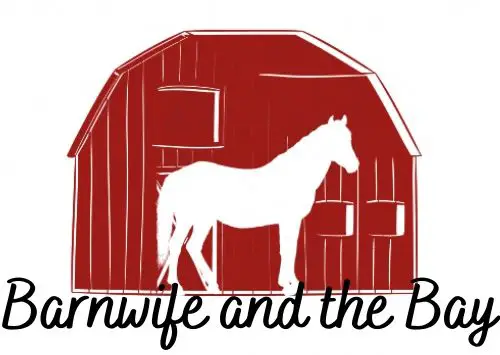
The best horse breed for heavy riders is one that is stocky and athletic enough to carry weight with ease.
How much weight can a horse carry?
The answer to this question depends on a number of factors.
What kind of weight?
One factor is, what kind of weight is it? A horse will have a different capacity for carrying if the weight is an inanimate pack (dead weight) strapped properly and securely to its back than if it is a rider (live weight).
Rider ability
The ability of the rider also plays a large role. If a rider can ride in good balance with the horse and use different parts of their body independently, weight is not as much of an issue. For example, a given horse may have an easier time carrying a 6’3” tall, 200lb professional show jumping rider than a 5’6” tall, 150lb rider who has just climbed on a horse for the first time.
Horse fitness
Another important factor to consider is the fitness and training of the horse. A very strong horse trained to use its abdominal muscles and carry weight properly will be able to carry more weight without strain than an unfit or improperly trained horse.
Breed of horse
Finally, horse size and build of the horse are the most important factors to consider. A general rule of thumb that veterinarians have been suggesting for the past few years is to limit the live weight a horse is asked to carry to 25% of the horse’s weight. However, recent research is suggesting there is risk of lameness and discomfort to the horse (even with an experienced rider) when the total weight of rider and tack exceed about 15% of the horse’s own weight.
It’s important to keep in mind that western saddles, even more than English saddles, have significant weight to them. Don’t forget about that when calculating the total weight on a horse’s back.
Best horse breed for heavy riders
People come in all sizes, and thankfully, so do horses!
People of almost any stature and weight can enjoy horse sports, thanks to the wide variety of different breeds available to partner with.
For those of you who may be very tall and/or heavier riders, here are the 21 best horse breeds to choose from:
Draft breeds (heavy horses)
The weight limit for these gentle giants is the highest of any on the list. They are on average the largest horse breeds in the world. Some draft breeds like the Percheron and Shire claim ancestry with the most prized war horses of the Middle Ages, called destriers. However, they are probably much taller and heavier than those horses would have been.
In general draft breeds display a calm demeanor and are very patient, thanks to their history of being needed for heavy work around farms.
They are known for their calm temperament, and are a great choice if you want to trail ride or show in breed shows.
Shire horse

Topping the list for size is the Shire horse breed.
- They are the tallest horse breed, with the minimum height for a Shire stallion around 17 hands, or 68in (173cm) and they can weigh 2000-2500lbs (900-1100 Kg).
- The Shire breed is a very old breed originating in England. Records of the breed begin to appear in the late 1700s. They were prized for their size and used mainly to pull farm implements and carts.
- Now, studbooks and breed associations exist for Shire horses in Great Britain, the United States, Australia, and Canada.
Belgian draft horse
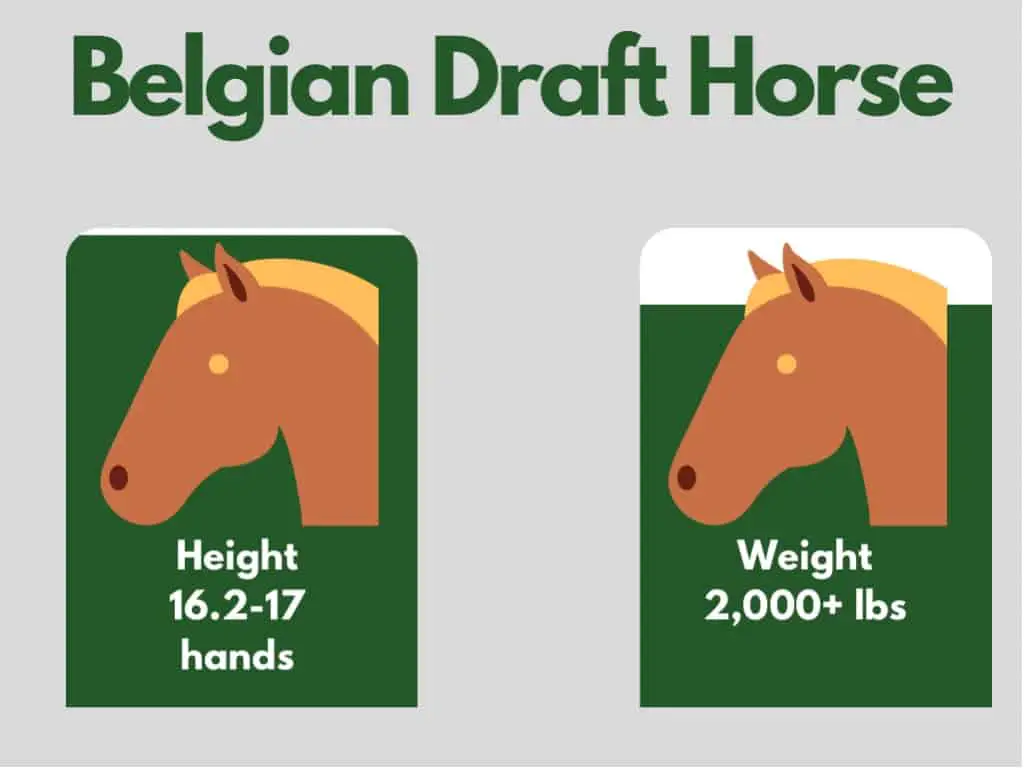
Height: between 16.2 and 17 hands (66 and 68 inches, 168 and 173 cm)
Weight: around 2,000lbs or more (900kg)
- As their name suggests, Belgians originated in what is now Belgium. They can now be found all over the world.
- Belgians are the most numerous draft breed in the United States, where most Belgian horses are light chestnut with flaxen mane and tail.
Dutch draft horses
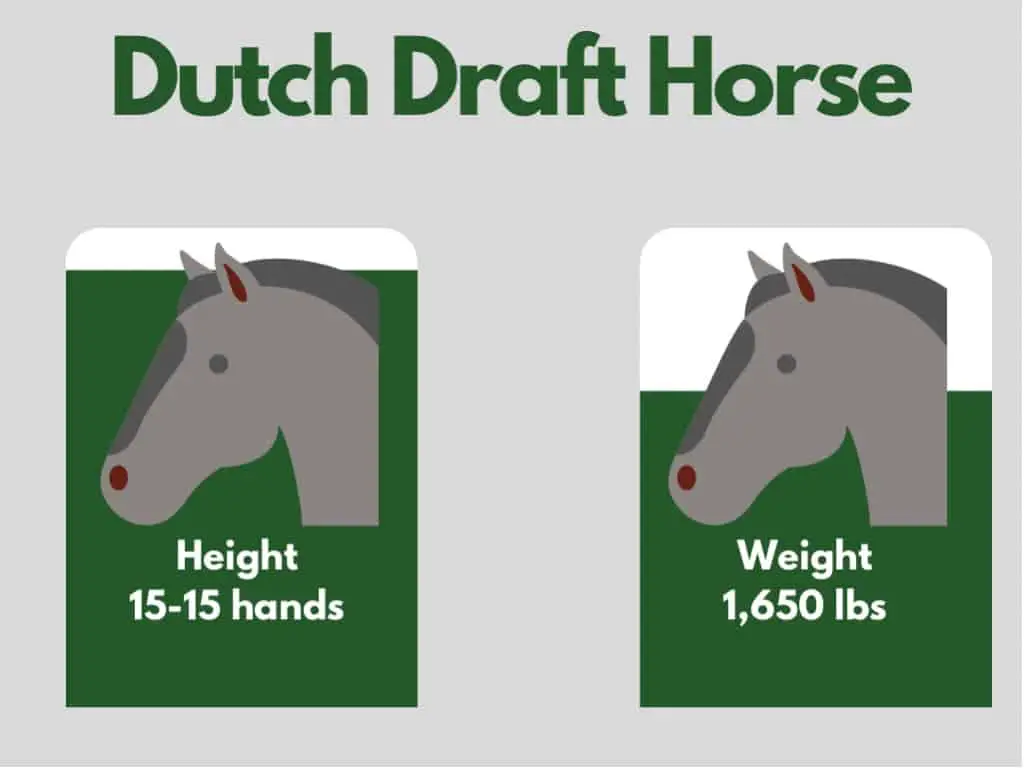
Height: about 15-16 hands (63in, 160cm)
Weight: about 1,650lbs (750kg)
- Dutch drafts are the variation of draft horse that was developed in the Netherlands.
- They come in many different coat colors, and usually have heavily feathered legs.
Clydesdale horse
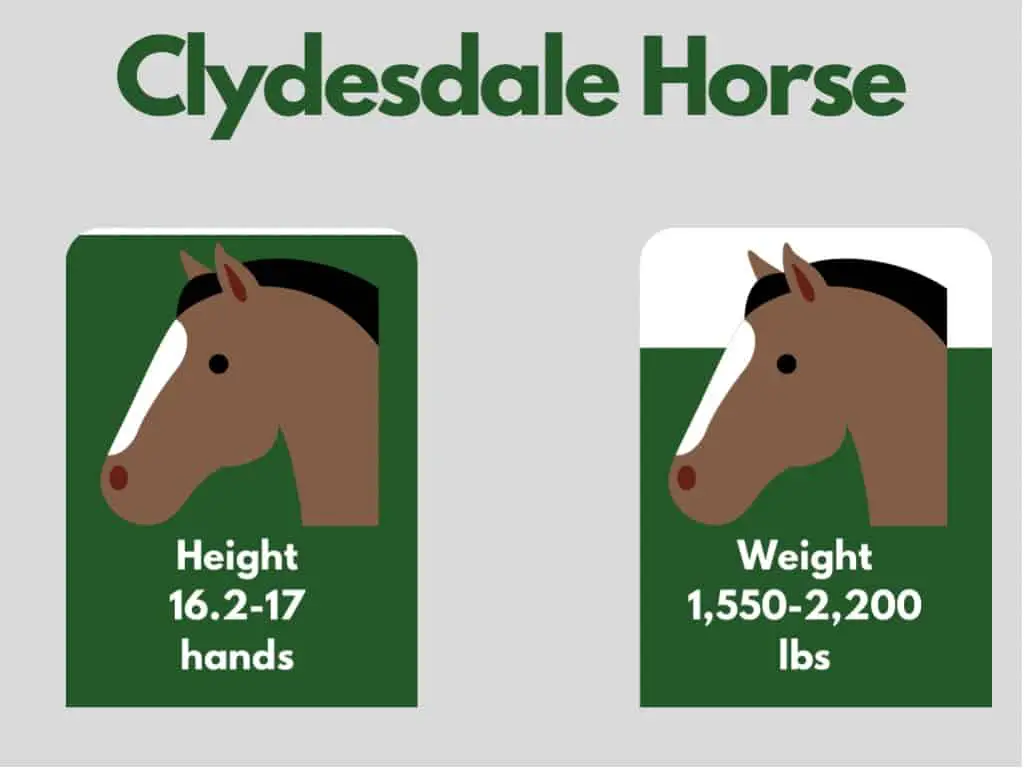
Height: about 16.2-17 hands (68in, 172cm)
Weight: about 1,550-2,200lbs (700-1,000kg)
- The Clydesdale breed is named for the valley of the river Clyde in Scotland, where it originated.
- Clydesdales are bred for activity of gait. They lift their hooves high and move in a more showy way compared to other drafts.
- Clydesdales can come in any coat color, and usually have some white markings. They also have extensive feathering on the legs.
Percheron horse
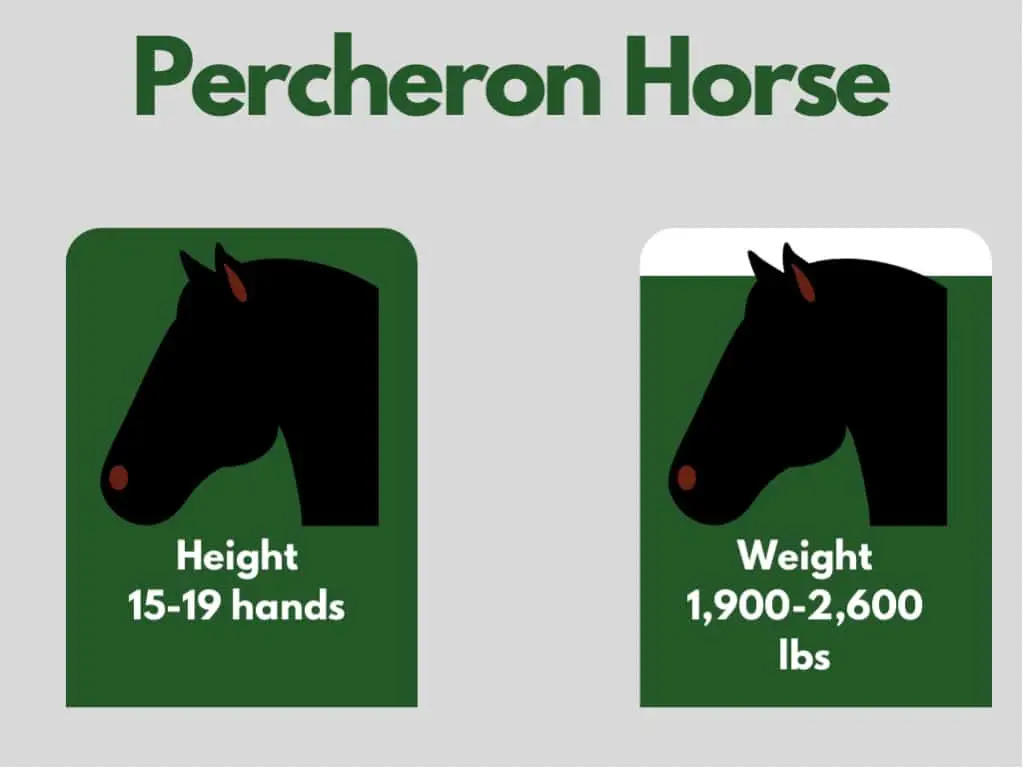
The size of Percheron horses can vary greatly around the world.
Height: varies between 15–19 hands (60–76 inches, 152–193 cm)
Weight: 1,900 pounds (860 kg)-2,600 pounds (1,200 kg)
- Percherons are the draft breed originating in France. The first Percheron studbook was established there in 1883.
- Now, you can find Percherons all over the world. They are a fairly popular draft breed in the United States.
- Percherons usually have grey or black coats, without much feathering on the legs.
Irish Draught
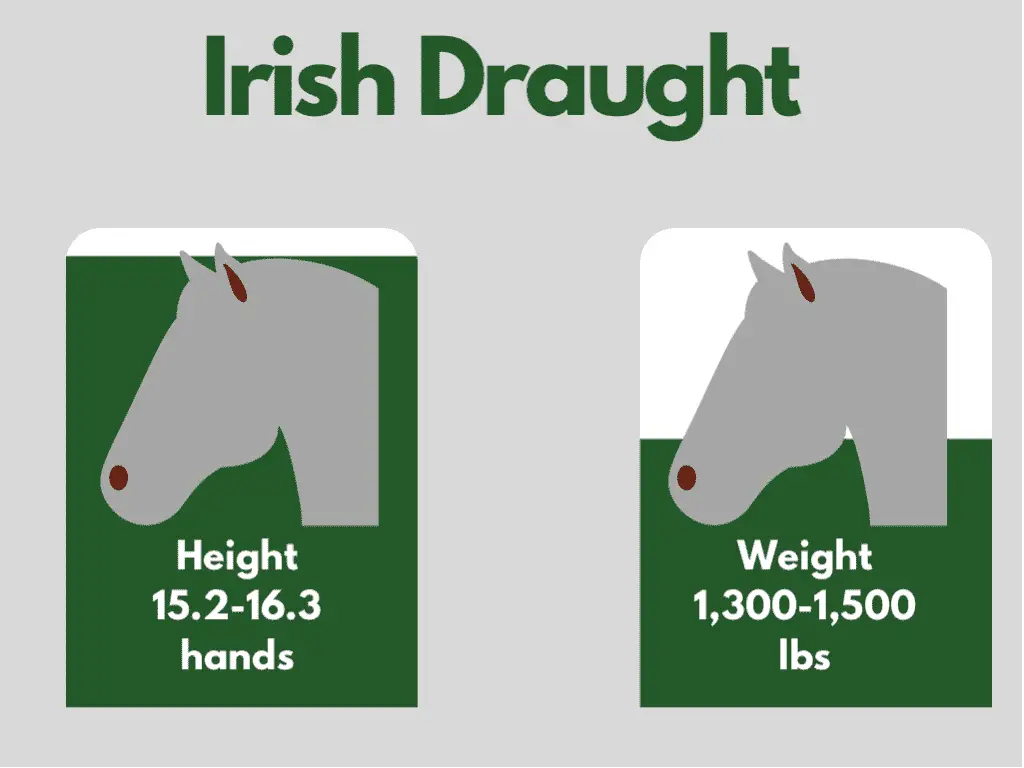
Height: 15.2 hands (62 in,158cm) – 16.3 hands (67 in, 170cm)
Weight: 1,300lbs (590kg) – 1,500lbs (680kg)
- Irish Draughts are a relatively rare horse breed, even though they are the national horse breed of Ireland.
- Like other draft breeds, they were originally bred primarily for farm work, but now mainly sought after for crossing with thoroughbreds and warmbloods to produce Irish sport horses, which are popular with competitors in eventing and show jumping.
- Pure Irish Draughts are also shown in special heavyweight hunter classes.
- Irish Draughts come in solid colors, with large white markings being undesirable to breed enthusiasts.
Suffolk Punch
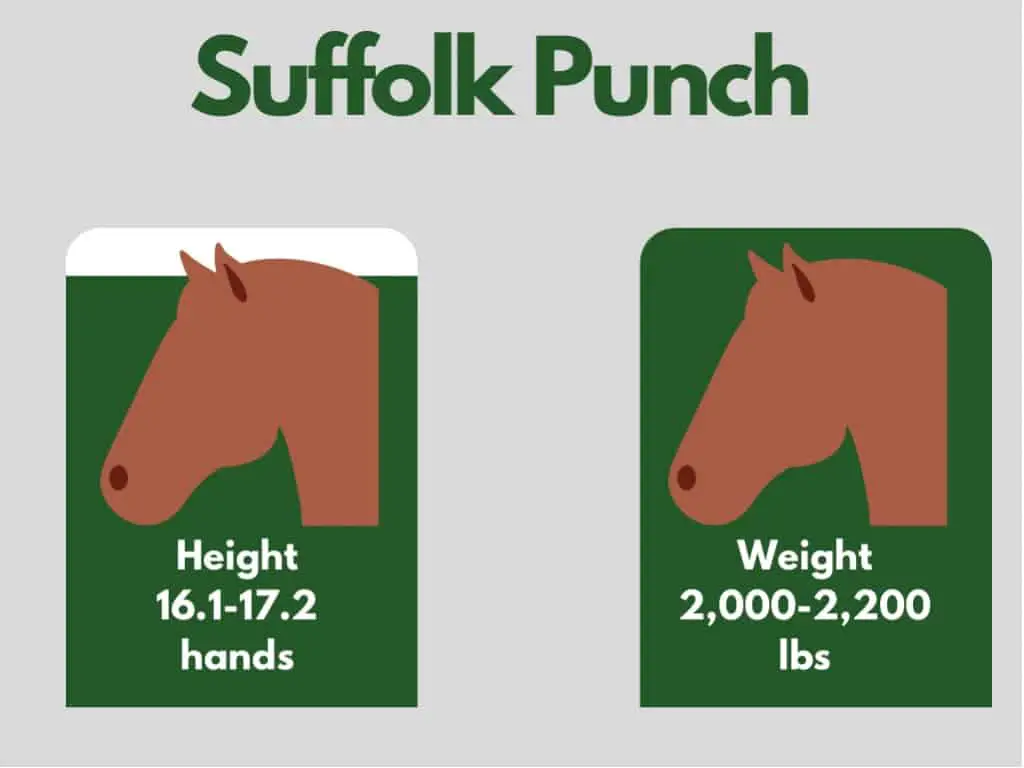
Height: 16.1 hands (65in, 165cm) – 17.2 hands (70in, 178cm)
Weight: 2000 – 2200 lbs (900 – 1000 kg)
- The Suffolk Punch is named for the county of Suffolk in England and is a very old English breed.
- Now the breed is extremely rare.
- Suffolk Punch horses are always chestnut color, white markings are rare.
- Tend to be shorter but even more massively built than the other British breeds.
Draft crosses
Finally, any breed crossed with a draft breed is likely to have a heavier build with good bone structure for carrying more rider weight.
Large horse breeds (light horses)
These breeds are not as large or heavy as draft horses, but tend to be on the tall side, as well as a little thicker in bone structure and heavily muscled.
Friesian horse
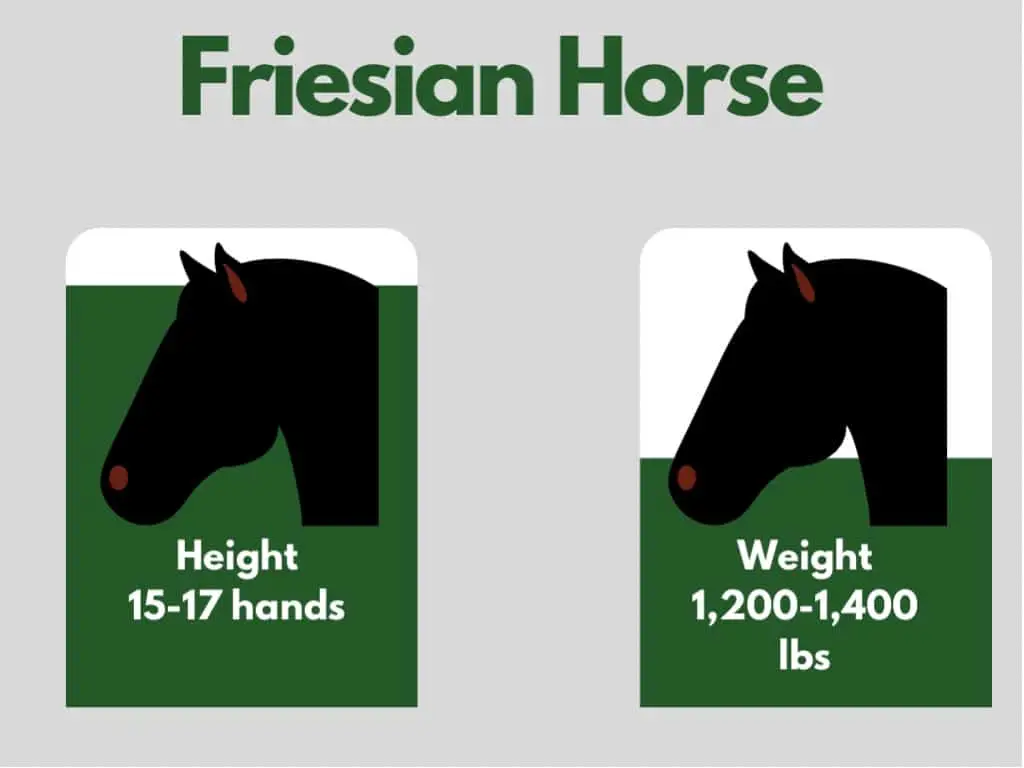
Height: about 15 – 17 hands (60 – 68 inches, 152 – 173 cm)
Weight: about 1,200 – 1,400lbs (544 – 635kg)
- Originating in the Netherlands, it’s likely that these modern horses more closely resemble the war horses of the middle ages than modern draft breeds do.
- Friesians are widely considered some of the most beautiful horses in the world, with a proud, high head carriage and high-stepping gait.
- They are almost always black, with thick mane and tail and thick feathers on the legs.
- Well-developed musculature and fairly heavy bone structure.
Dutch warmblood, or KWPN

Height: most are at least 15 hands (60in, 152cm)
Weight: about 1,400lbs (635kg)
- Another breed of highly athletic horses created by the Dutch.
- Very successful at dressage and show jumping.
- Registered Dutch warmbloods are selected to be uncomplicated to handle and ride, while still having the potential to be world-class athletes.
Other warmblood breeds
- Many other warmblood breeds have been developed around the world to have similar characteristics and athleticism to the KWPNs.
- Warmblood breeds are often ridden in world competitions by professional human athletes of all sizes and builds and still excel at jumping very high obstacles and performing complicated maneuvers.
- Warmbloods can come in many different coat colors, including black, brown, bay, chestnut, and grey, with white markings also being common.
Cleveland bay

Height: 16 – 16.2 hands (64 – 66 in, 163 – 168 cm)
Weight: 1,400 – 1,500lbs (635 – 680kg)
- Yet another old English breed, the Cleveland Bay is named for its color (always bay) and area of origination in the Cleveland District of Yorkshire.
- The Cleveland bay is known as an excellent riding horse and pulling horse, with a stocky build and legs that are strong and short relative to its body length.
- It has sometimes been crossed with thoroughbreds to create a warmblood sporthorse.
Smaller horses (light and draft horses)
Arabian horses
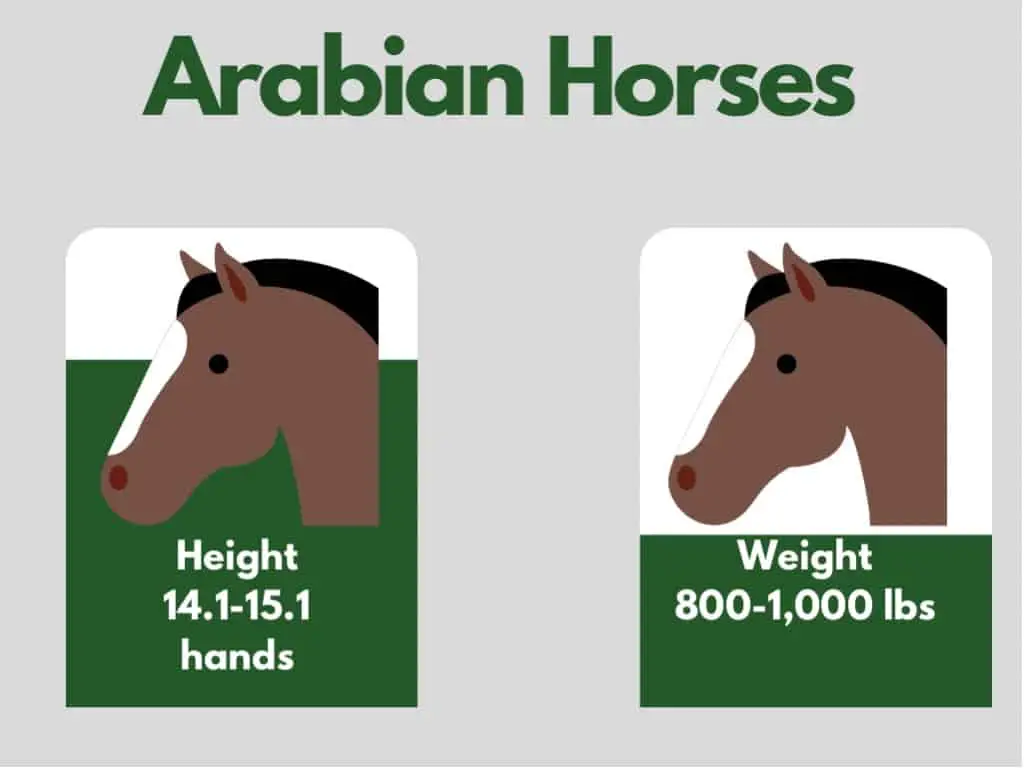
Height: 14.1 – 15.1 hands (57 – 61in, 145 -155cm)
Weight: 800 – 1,000lbs (360 – 450kg)
- These are usually smaller horses and light-boned, so are not suitable for very heavy riders. However they are extremely tough.
- Arabian horses originally come from the Middle East, where they were bred in ancient times.
- Arabians excel in the sport of endurance riding, which is popular in many areas of the world, and especially in the Middle East
- The toughness of the Arabian shows in its ability to go long distances and over rough terrain during an endurance race. Endurance horses then have to pass a heart rate check at the end of the race to make sure the effort was not unduly strenuous for them.
Morgan horse
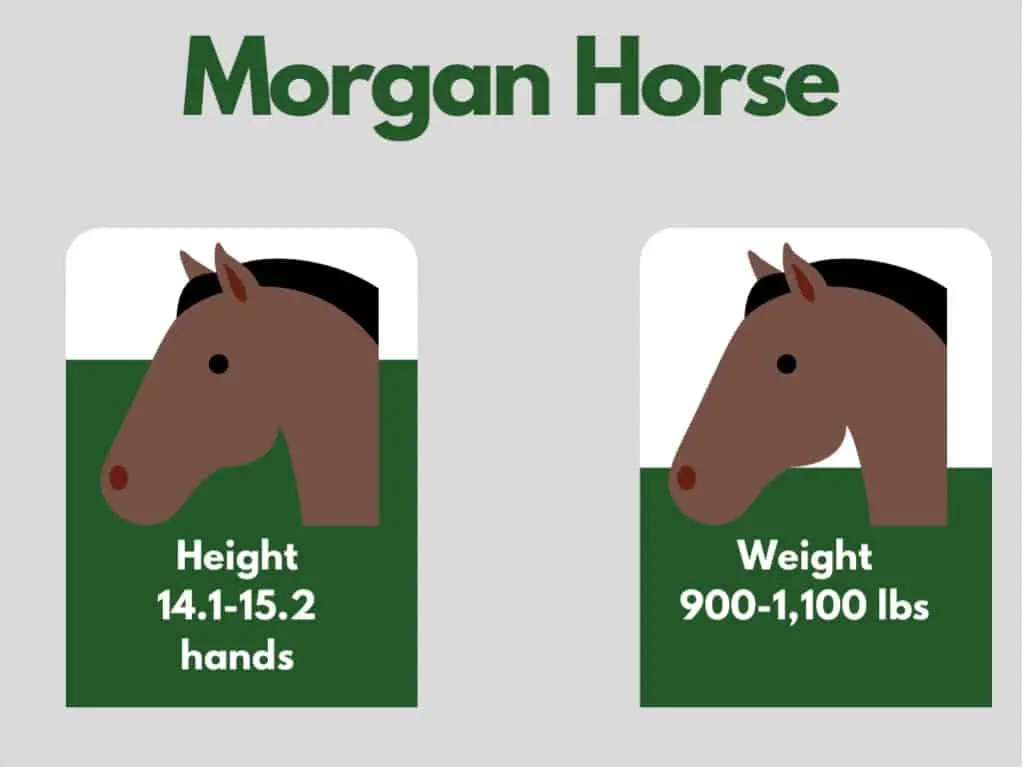
Height: 14.1 – 15.2 hands (57 – 62in, 145 – 157cm)
Weight: 900 – 1,100lbs (400 – 500kg)
- The Morgan horse is an American breed. In fact, it is one of the first horse breeds developed in America.
- They have now spread around the world.
- Usually bay, black, or chestnut, but they can come in many different coat colors.
- A smaller to medium size horse, Morgans usually have a little heavier bone structure than Arabians, and are very versatile and strong.
- Some Morgans are gaited, which means they can perform an intermediate gait other than walk, trot, and canter. This could be a rack, fox trot, or pace.
- Morgans often have a showy movement and do well in saddle seat competitions and breed shows.
American paint horse
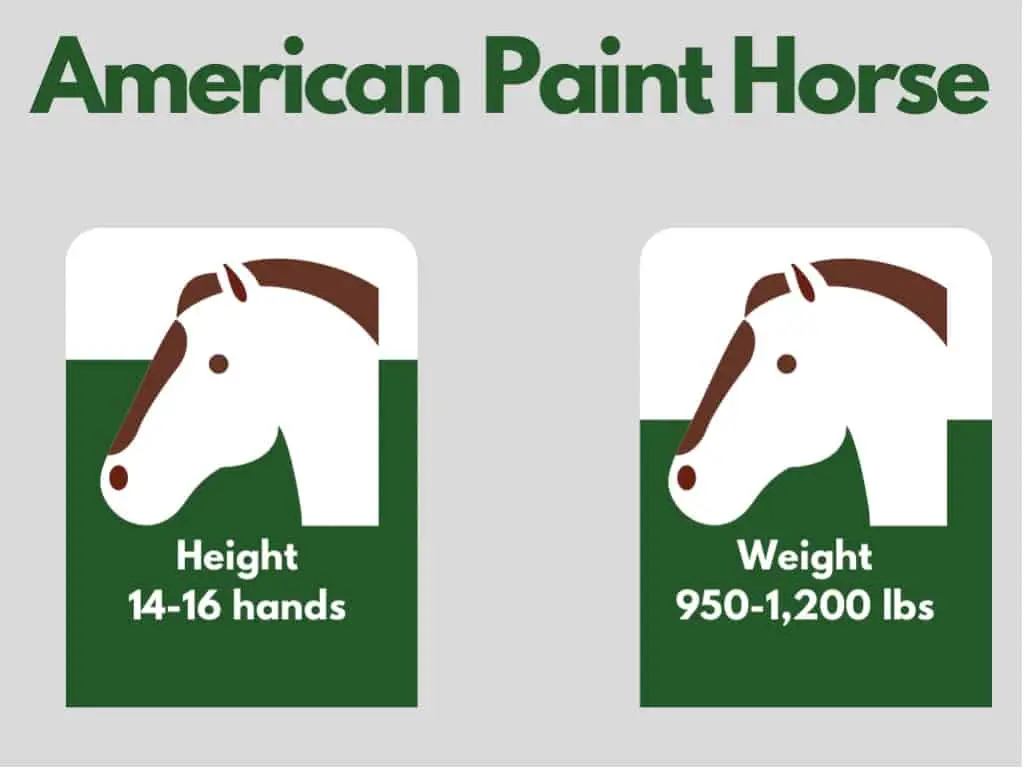
Height: 14 – 16 hands (56 – 64in, 142 – 162cm)
Weight: 950 – 1,200lbs (430 – 544kg)
- Another American breed that is recognizable for its unusual splashes of white mixed with all different coat colors, although some Paints are solid colored.
- Paints fall into a category of breeds called “stock horses” and indeed have a rather stocky build.
- Powerful hindquarters and shoulders and well-developed musculature are characteristic features of all stock breeds.
- The American Paint Horse is one of the most popular horse breeds in the United States
Appaloosa

Height: 14 – 16 hands (56 – 64in, 142 – 162cm)
Weight: 950 – 1,200lbs (430 – 544kg)
- Another very popular stock horse breed in the United States.
- Appaloosa horses are characterized by striking spotted coloring, but often have very thin manes and tails
- This breed is also notorious for being susceptible to an eye disease known as uveitis, which can lead to eye pain and blindness.
American quarter horse
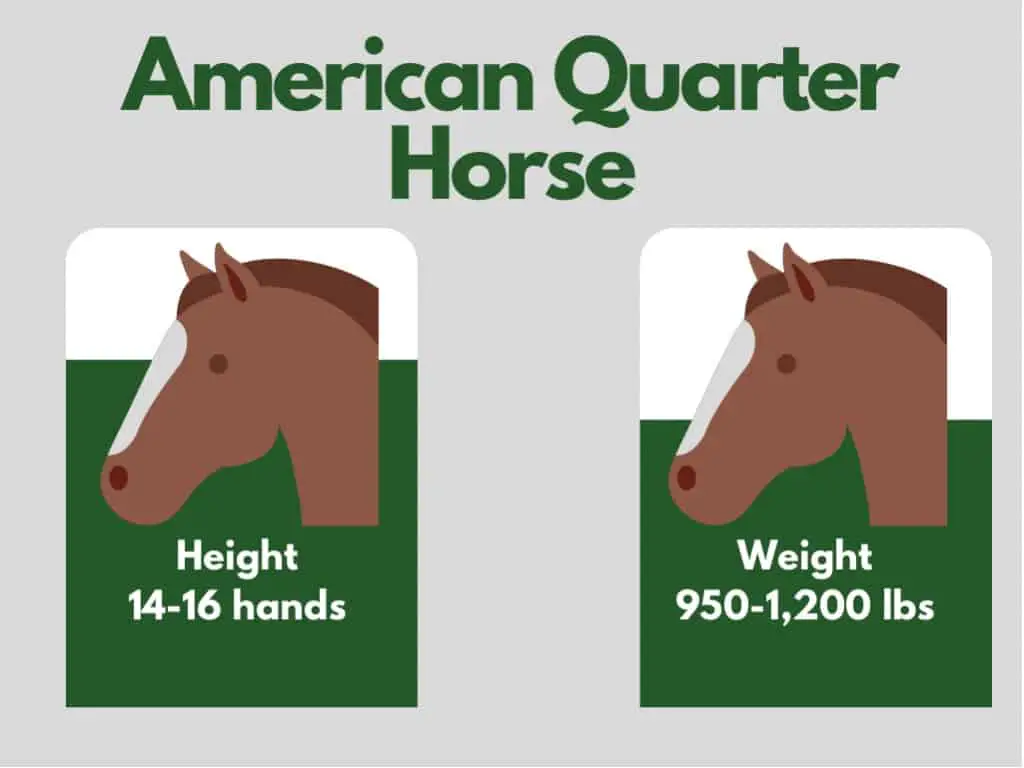
Height: 14 – 16 hands (56 – 64in, 142 – 162cm)
Weight: 950 – 1,200lbs (430 – 544kg)
- Another very popular stock horse breed in the United States.
- The American Quarter Horse Association is the world’s largest equine breed registry, with over 6 million horses registered.
- Quarter horses have been bred for racing over short distances, and there is still a popular Quarter Horse racing industry in North America.
- Other sports at which quarter horses and other stock breeds excel are barrel racing, other speed events, and all Western disciplines, as well as ranch work.
- You can see world-class Quarter Horse athletes competing in national and international competitions carrying professional human athletes of all sizes and builds (and heavy western saddles) performing high-speed maneuvers, tight turns, spins, and sliding stops.
Icelandic horse
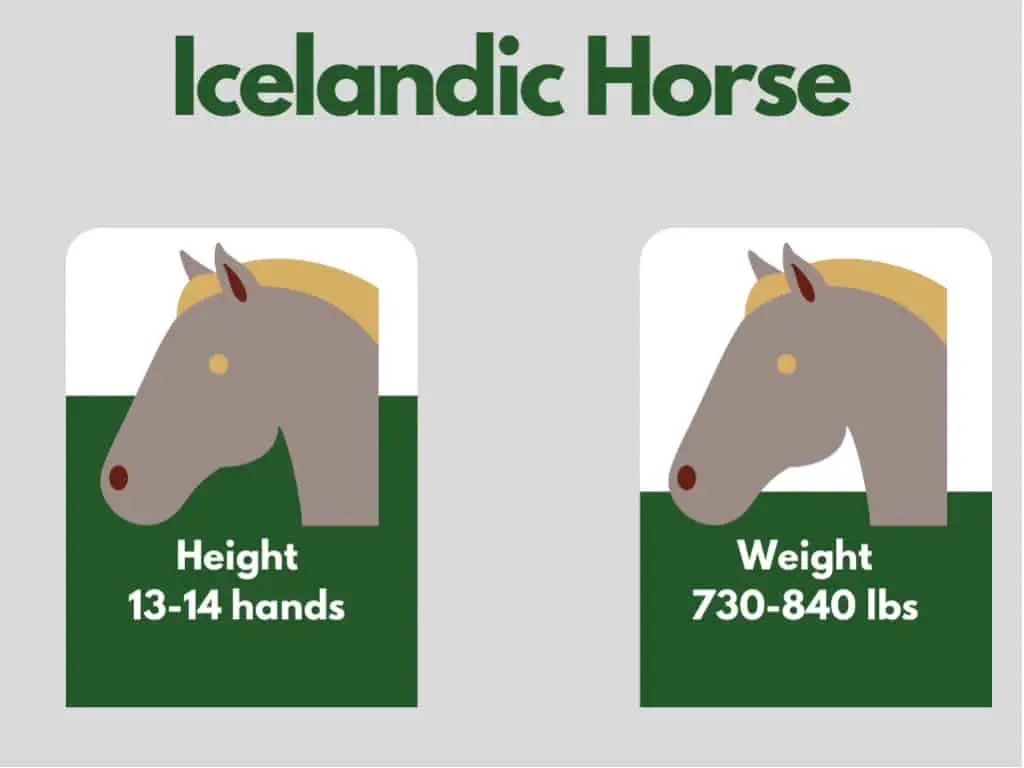
Height: 13 – 14 hands (52 – 56 inches, 132 – 142 cm)
Weight: 730 – 840lbs (330 – 380 kg)
- As the name suggests, this breed originated in Iceland. There are Icelandic breed registries in 19 different countries today.
- These horses are small but very hardy, and tend to live a long time.
- They have thick and muscular bodies.
- Icelandic horses are five-gaited horses. They can perform two gaits in addition to the normal walk, trot, and canter.
- One gait that is unique to this breed alone is the tölt. The tölt is a smooth gait, consisting of four beats. It is a very comfortable gait to ride, but is very fast.
- Another extra gait that some Icelandic horses can do is the flying pace. This gait is common to American Standardbreds as well, but Icelandic horses are not encouraged to perform a slow pace, only a very fast, flying pace.
Andalusian horse
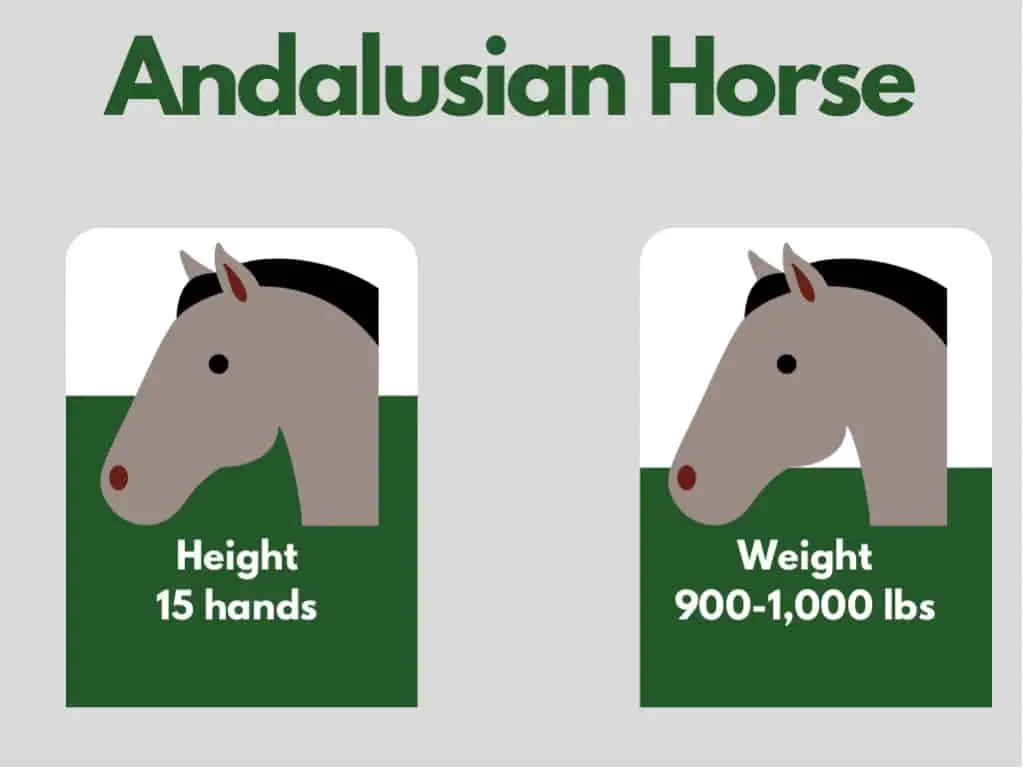
Height: about 15 hands (60in, 152cm)
Weight: 900 – 1,100lbs (410 – 510kg)
- These Spanish horses from the Iberian Peninsula are strongly built and compact. They have an elegant movement and very thick manes and tails.
- Andalusians have consistently been bred for athleticism, and excel in many sports, including dressage.
- They are also shown in traditional performances, such as in-hand “Cobra” presentations.
- Most are grey or bay. In the United States, the majority of Andalusians are grey.
Lusitano horse
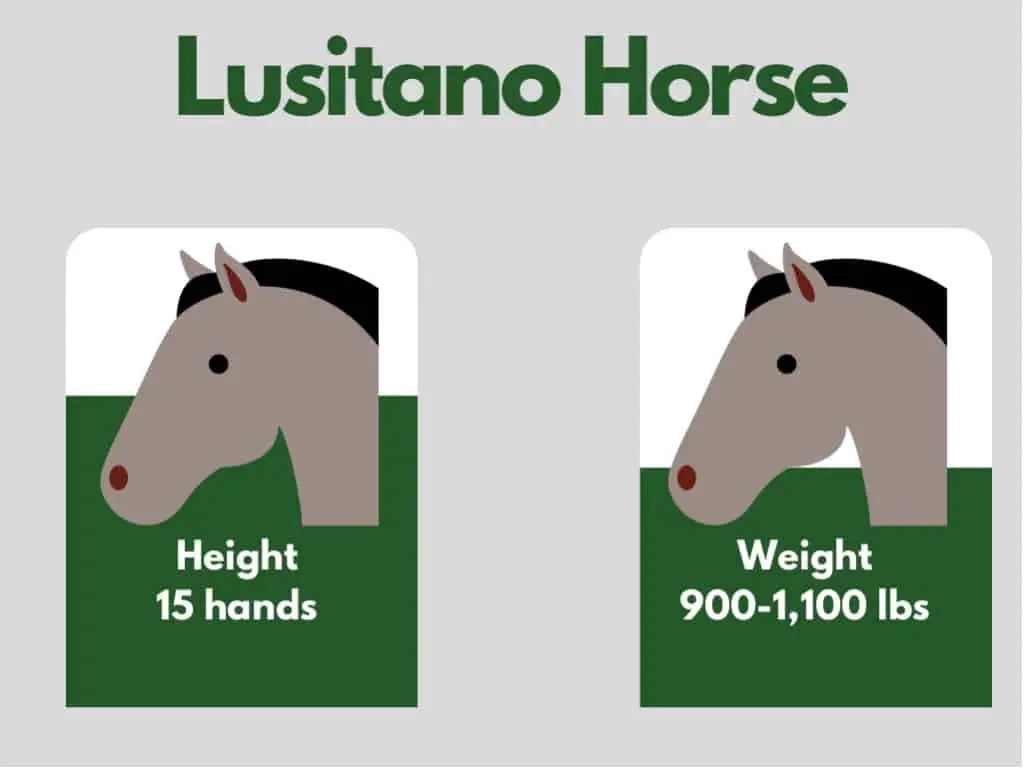
Height: about 15 hands (60in, 152cm)
Weight: 900 – 1,100lbs (410 – 510kg)
- Lusitano horses originated in Portugal, with similar heritage to the Andalusian horse.
- They have an elegant movement and very thick manes and tails.
- Lusitanos are bred for athleticism, and excel in many sports, including dressage, driving, and mounted bullfighting.
- Most are grey, bay, or chestnut, but they can be any solid color
Halflinger
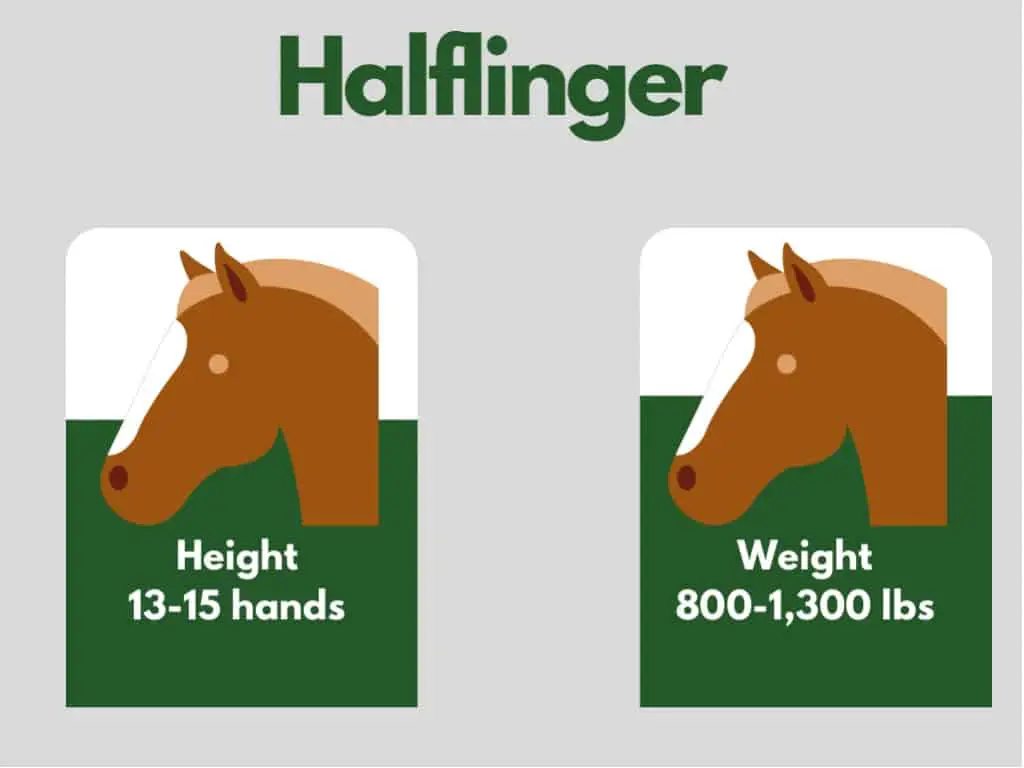
Height: 13.2 – 15.0 hands (54 – 60 in, 137 – 152 cm)
Weight: 800-1,300lbs (360 – 590kg)
- Halflingers come originally from Austria and Northern Italy.
- They are considered a draft breed although they are typically much smaller than other draft horses.
- Their very thick bone structure and muscular body are similar to all draft breeds.
- Another characteristic that halflingers share with their larger draft cousins is their calm and patient temperament.
- Always chestnut colored, with flaxen mane and tail.
Like This article? Ready to learn more? Jump into these too:
- 24 Best Dressage Horse Breeds (Plus Nontraditional Breeds)
- How To Adopt Your Perfect Horse
- Yoga Has Helped Me Ride Better
- Medicine Hat Paint Horse: Fascinating Facts
